When you talk to guitar players about why they started playing and what inspired them, it's fairly common to hear them reference a scene in a landmark movie. For many players, a memorable moment on the big screen had as much of an influence on them as an era-defining album or groundbreaking live performance. While some kids spent their childhood longing for Angus Young's Gibson SG, other kids grew up dreaming of Marty McFly's ES-345.
Here at Reverb, we thought it would be fun to explore these movie moments and the instruments behind them. We've identified some of the most famous axes from a number of celebrated films and modern cult classics. When possible, we tell the true stories behind them.
There are so many timeless music moments in movies that we'll likely do another installment down the line. But there's simply not enough time or space to include them all here. To start, we've compiled the guitars—mainly electrics—from eight of our favorite movies.
Have your own favorite guitars from other films? Let us know in the comments.
If you were alive in the '80s and the early '90s, it's hard to forget the totally excellent cultural impact of 1989's Bill & Ted's Excellent Adventure.

In case you missed it, Bill and Ted is the story of two time-traveling, heavy metal–loving high school burnouts who end up creating a perfect rock 'n' roll–based utopia of the future, all as a result of trying to pass history class and avoid military school. It also co-stars stand-up comedy legend George Carlin (Rufus), alongside the then-rookie actors Keanu Reeves (Ted) and Alex Winter (Bill).
Both of the main guitars throughout this movie—those Bill and Ted play up until the movie's final performance—are actually quite rare, though not exactly good guitars. The reason ultimately is spelled out in the movie's story arc: Bill and Ted were supposed to have started on junk guitars before being gifted guitars of the future—Steinbergers, of course—by the time-traveling Rufus.
1973 Ibanez 2375N
The first guitar up is Ted's decal-less Stratocaster copy. Both of the stoner heroes' guitars are difficult to identify, and it takes some serious knowledge of early Ibanez and lawsuit-era guitars to figure this out.
Based on vintage catalogs, at best guess Ted's mystery Strat would have been a 1973 Ibanez 2375N, with the N designating a natural finish.
While the catalog version of this guitar displays a different color pickguard and white truss rod cover, the shape of the truss rod cover in Bill & Ted matches the black covers on other Ibanez models at the time, and the headstock shape is a dead-ringer as well. While it can't be said for sure, this is most likely the correct identity of this guitar.

1965/'66 Murph Squire II T
What can be confirmed is the identity of Bill's pre-utopia guitar—the Murph Squire II T. While it looks like just another '60s MIJ Fender offset knockoff, Murph guitars have an interesting history in and off themselves.
Murph was a mid-'60s, California-based guitar company created by Thomas "Pat" Murphy that only lasted from 1965 to 1967. In that time they made a number of unique models (like 12-string electric with a vibrato system) at very low production numbers. Their most common and popular models were the Squires—not to be confused with Fender's Squier brand.
Bill's Squire II T, named in part for its two pickups, looks to be completely original, based on the film and pictures of others out there on the market. While these were originally marketed as true budget guitars—even selling through Sears catalogs in the '60s as such—today Murph guitars can fetch as high as $3,000 USD or more. Earth to Bill, you might want to flip that guitar for some more gear.

Late-'80s Steinberger GP2-S and Steinberger GP3T
The last significant guitars to make an appearance in Bill & Ted are a pair of headstock-less Steinberger GP models, presumably from '88/'89. While there have been some forum rumblings over the years that these guitars were made custom for the movie, it does appear that both are stock production models from the time of the film's release.
To support this, it has also been said by Steinberger World (the self-proclaimed "most authoritative and complete Steinberger site on the web") that Steinberger in fact did not pay for the guitars' inclusion, nor did they have any involvement in the selection of the guitars.

Walk Hard is a 2007 musical satire produced by Judd Apatow and starring John C. Reilly as Dewey Cox, an analogue of Johnny Cash, Bob Dylan, Brian Wilson, and more famous musicians at various points in the film.
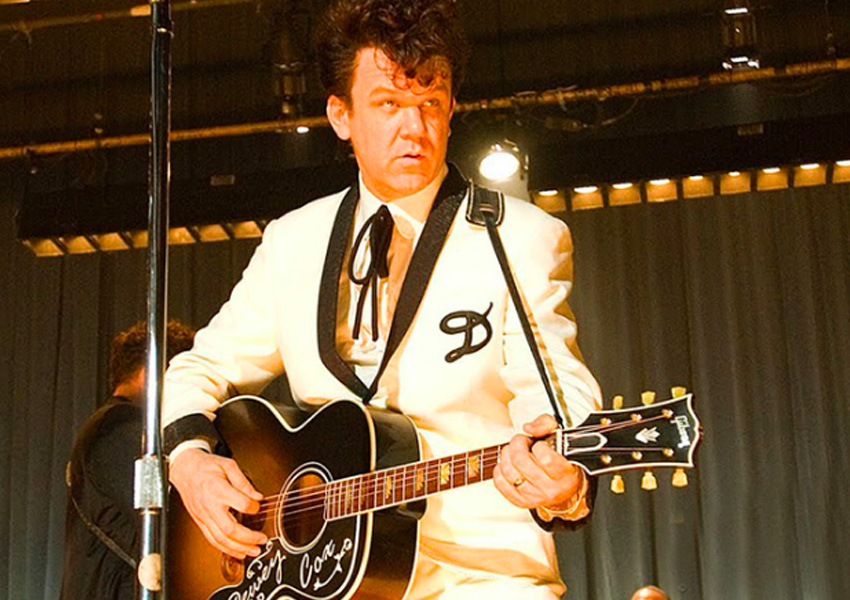
Throughout the course of the movie, Walk Hard brilliantly takes on the most absurd elements of celebrity musician biopics. While it was largely considered a box-office bomb, it has become a modern cult classic due to its layered cultural references and quotable jokes ("You don't want no part of this shit, Dewey").
The film takes on numerous eras of music spanning from the 1950s into the 2000s and achieves truly hilarious results at times. There's also a lot of cool gear in it, particularly acoustics, but, here, we're going to look mainly at a selection of the most prominent guitars.
2006 MIM Fender 60th Anniversary Telecaster
The first guitar from Walk Hard worth mentioning is the number one axe of Dewey's sideman known simply to the audience as Hank. The guitar makes an appearance in Cox's performances from the '50s, implying that it is supposed to be a vintage '50s blackguard Fender Telecaster. In truth, the guitar is a made-in-Mexican Fender 60th Anniversary Telecaster from 2006—a perfectly fine guitar in its own right.
Besides the glossiness of the finish, the ultimate dead giveaway is the Mexican serial number decal and 60th anniversary logo on the back of the headstock. With all of the guitar-nerding and nitpicking aside, it took me a decade (from my first viewing to getting tasked with this article) to notice the bait-and-switch.

1956 Gibson ES-175D or 2000s Custom Shop ES-175D
The next guitar on this list belongs not to Dewey Cox, but to Bobby Shad, a character based on the real-life musician. But Dewey does catch his big break while substituting for a sick Shad, playing Shad's own songs and guitar. What is interesting about this guitar is determining whether or not it is an authentic vintage Gibson.
While it does look like an authentic '56/'57-era ES-175D, with its P90 pickups and parallelogram inlays, it is possible that it could just be an accurate modern recreation of a vintage classic made specifically for the film. It is hard to say because between the various acoustics and electrics, it does appear that they used a mix of new and vintage instruments.
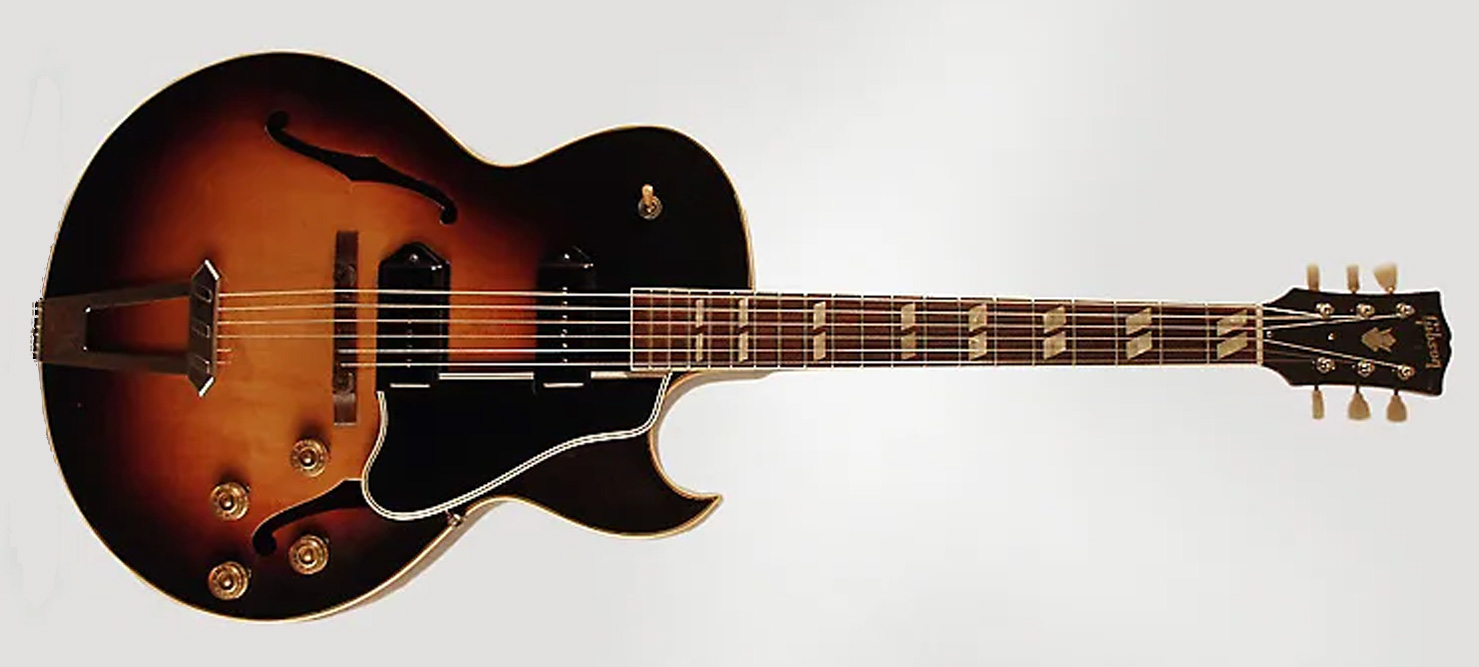
Custom Gibson J-200
Lending credence to that previous theory is the appearance of what clearly seems to be a custom Gibson J-200 acoustic being used by Cox throughout the film. While it does distinctively look like a vintage Gibson, the guitar sports a custom pickguard with Dewey's name inscribed on it. Of course, this could have been a modern modification, but, truthfully, what would be the point? At best guess, this and the other Gibson models featured in the movie are most likely Custom Shop productions.
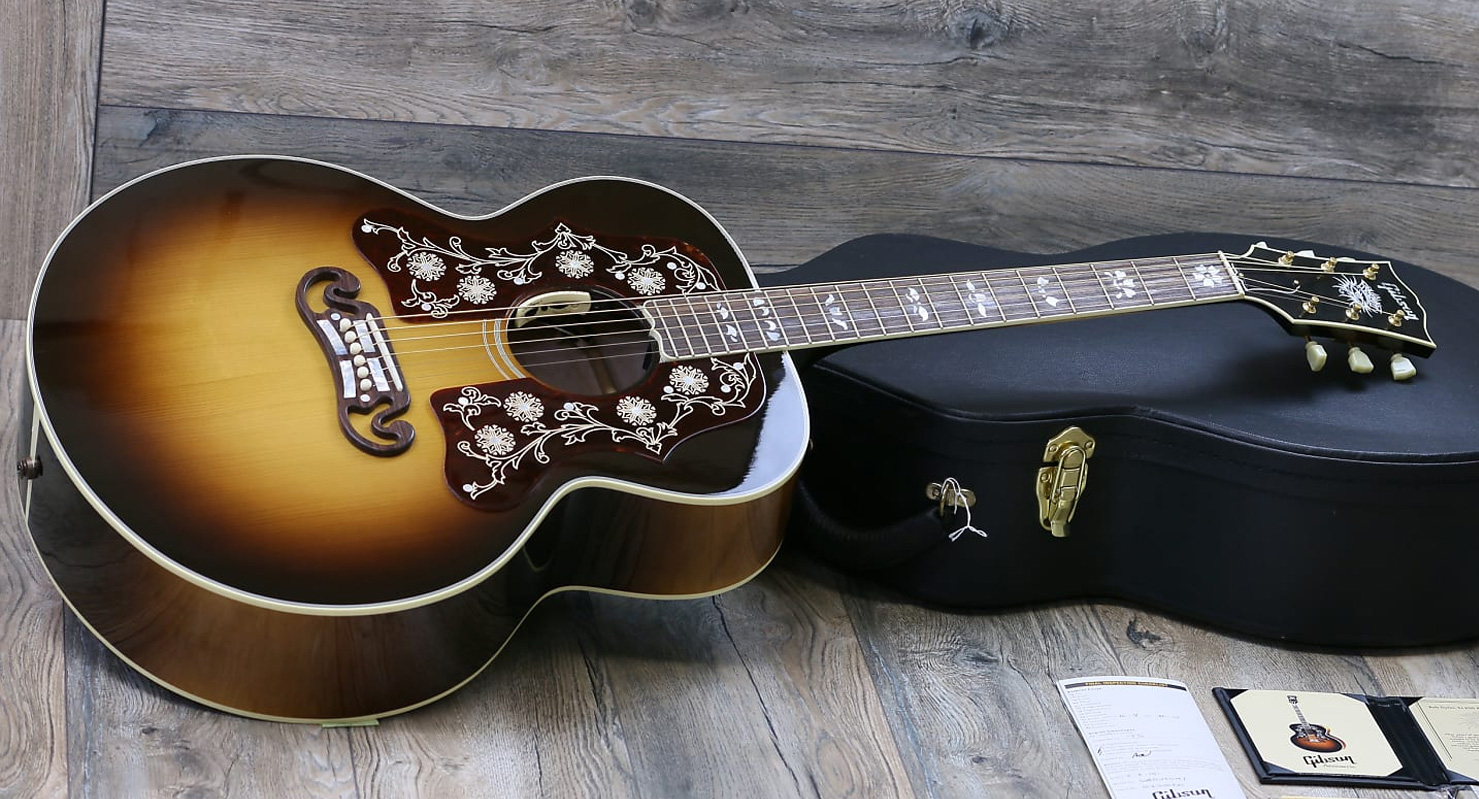
I likely shouldn't have to explain the synopsis of this movie on Reverb, given its status as a comedic classic.
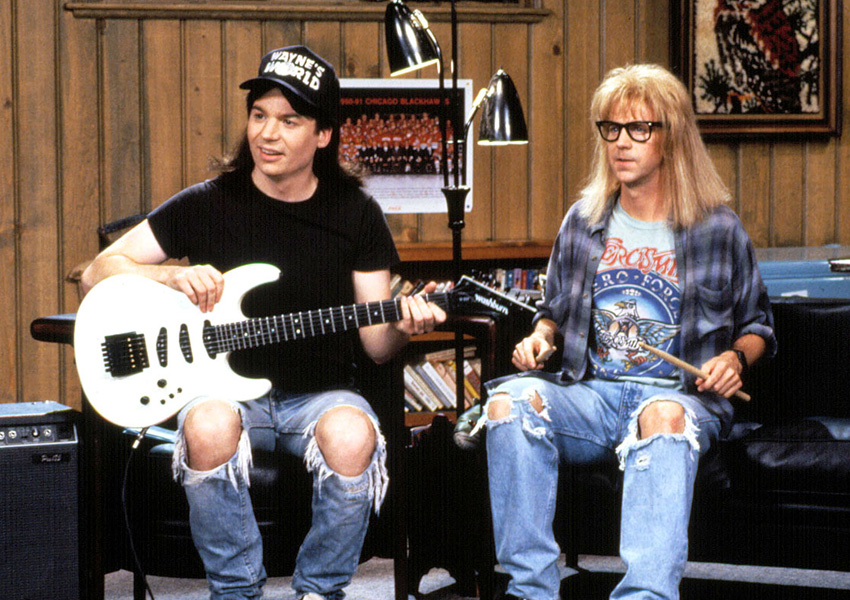
However, for the uninitiated: 1992's Wayne's World was a wildly successful Saturday Night Live spin-off starring Mike Myers as Wayne and Dana Carvey as Garth. Both lead characters are heavy metal-loving burnouts—a bit of a recurring theme in movies of the late '80s and early '90s—and co-hosts of a public access show.
In trying to save their show and protect Wayne's girlfriend from the predatory executive Benjamin, Wayne and Garth run into a number of memorable electric guitars, from Super Strats to what is supposed to be a real vintage Fender.
Washburn G-23V
A Super Strat/shredder guitar of the era, the Washburn G-23V is Wayne's humble go-to axe for most of the movie, until he's able to afford his "Excalibur" '64 Stratocaster. While Wayne had in previous skits played the G-20V, its two-humbucker brother model, the G-23V was used in the film. The G-23V was actually rarer, in that it sported three single-coil pickups.
Unlike many of the shredder guitars of the era, the G-23V didn't feature a Floyd Rose or Kahler tremolo, instead featuring Washburn's proprietary Wonderbar tremolo system. The verdict on the Wonderbar tremolo is historically split with a number of shredders declaring it their favorite tremolo ever, while others avoided it then and continue to avoid it like the plague.

Excalibur, aka '90/'91 MIJ Fender 1962 RI Stratocaster
Easily the most famous guitar in the entire series is Wayne's Excalibur. The movie claims the Fender Stratocaster of Wayne's dreams is a '64 Stratocaster in "classic white" (cough, olympic white, cough). Upon closer examination it is almost sure to be a Japanese Stratocaster from the beginning years of the '90s, specifically a '62 MIJ Reissue Strat or something in that vein, based on the decal and a few other facts.
The dead giveaway to me on this is the prevalence of Japanese Fenders throughout the film, as well as the pristine, glossy quality of the guitar's finish—and what looks to be a black string tree on Excalibur, the kind most commonly associated with Fender Japan guitars from the '80s or early '90s. Specifically, Cassandra's array of basses and a vast majority of the guitars displayed in the store where Wayne buys Excalibur are Japanese—often MIJ Fender guitars—so it would only make sense at that point that the real Excalibur was also Japan-made. Re-watch the famous scenes for yourself with a critical eye. If I'm lying, I'm dying.
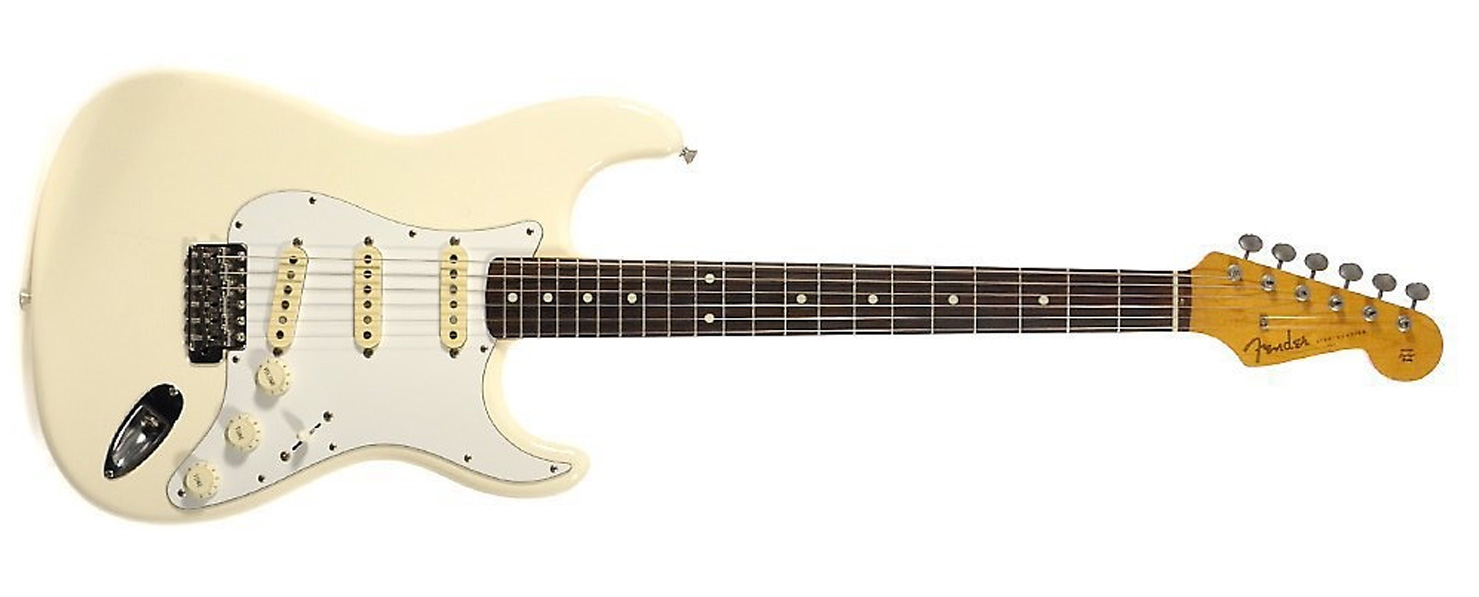
Another classic that needs little explaining is 1987's La Bamba, which stars Lou Diamond Phillips. It's a groundbreaking biopic about ill-fated Mexican-American musician Ritchie Valens.
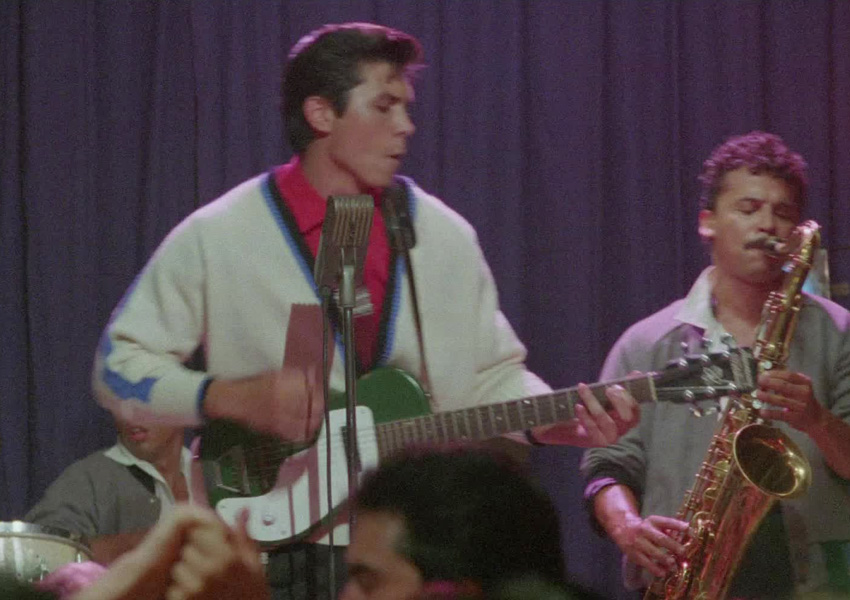
The movie follows the "La Bamba" singer's rise from poverty to stardom. Of course, it ultimately concludes with Valen's untimely death alongside the Big Bopper and Buddy Holly in their tragic airplane crash.
The movie was celebrated enough to make a bonafide star out of Lou Diamond Phillips and introduced Ritchie Valens to a whole new generation of listeners. Aside from all of that, Norman Harris of Norman's Rare Guitars actually supplied the instruments for this movie—and he was kind enough to assist us with this article where he could, and many thanks to him for that.
Early '50s Harmony Stratotone H44
One of the main guitars in the film and in the promotional materials is a Harmony Stratotone H44 which Valens was known to play. According to Harris, the film's screenwriter was concerned with having the correct Harmony guitars that Valens would have played. Being the undisputed baron of rare guitars, Norm was able to procure two separate Harmonys for the production, with the other being a white Archtone.
While the exact year of the model used in the movie is not known, Stratotone H44s were originally produced from 1952–57. In 2008, almost 21 years after La Bamba's release, Harmony actually did a Ritchie Valens signature model based off of this very H44.

1985/'86 Fender Stratocaster '57 Reissue
In a number of pivotal scenes throughout the movie, Valens is seen playing a vintage-style sunburst Stratocaster. Whenever Buddy Holly shows up in the movie, he's obviously depicted playing a clean, pre-CBS style sunburst Fender Stratocaster. To my eyes, Holly and Valen's guitars looked like the exact same Stratocaster and not necessarily a true vintage one. I wasn't wrong either!
While the producers could have very well rented a vintage Stratocaster in great condition from Norm at the time, they instead opted to use a Fullerton-made '57 Reissue Stratocaster. The extra cost and risk involved in a vintage instrument of that caliber ultimately stopped the producers from the real deal.
The dead giveaways for the guitar being a reissue were that the 12th-fret inlay dots are actually closer together, as they are on the reissue models, and that the truss rod plug is larger than it would be on a vintage '50s Strat. Another big clue was the relatively pristine appearance of the guitar and fingerboard. The movie's guitar clearly has a non-glossy nitro finish, but it doesn't exactly look like a true vintage sunburst Strat when you study it more closely.
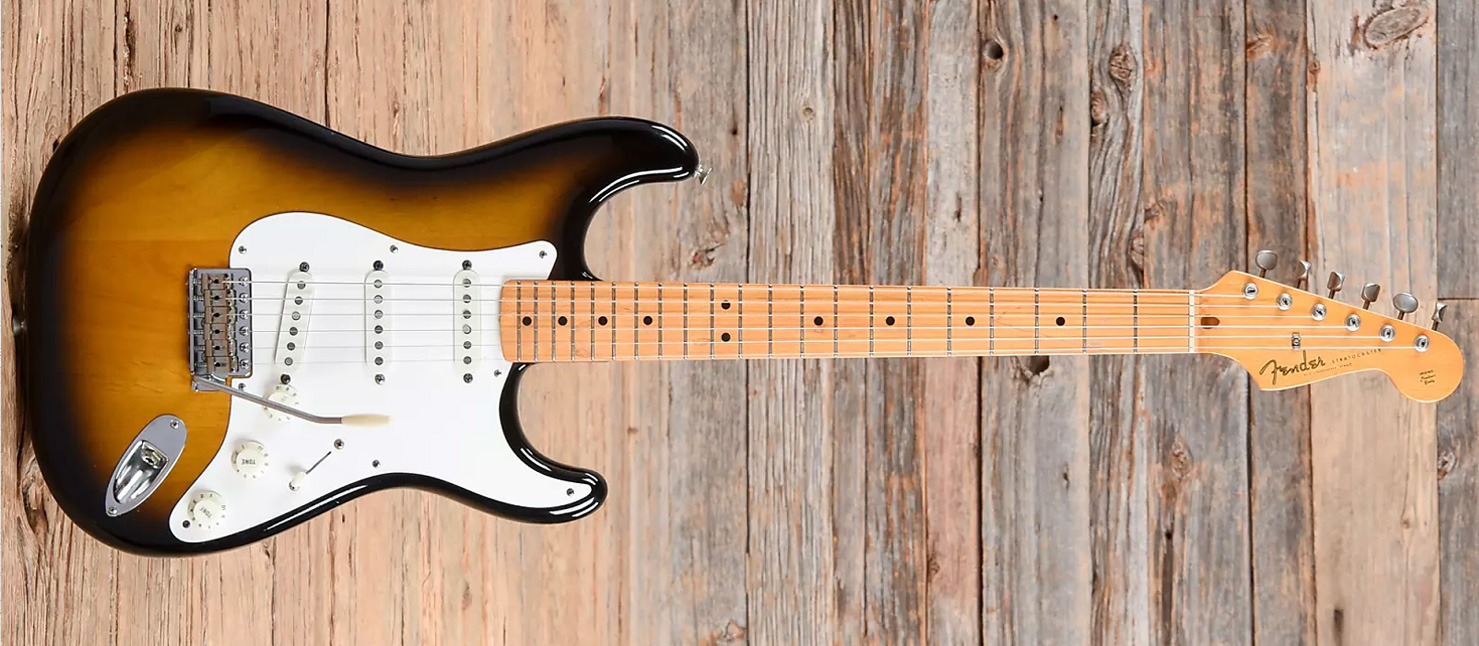
Did I mention '80s moviegoers had a thing for teenage slackers who loved metal and time-traveling?
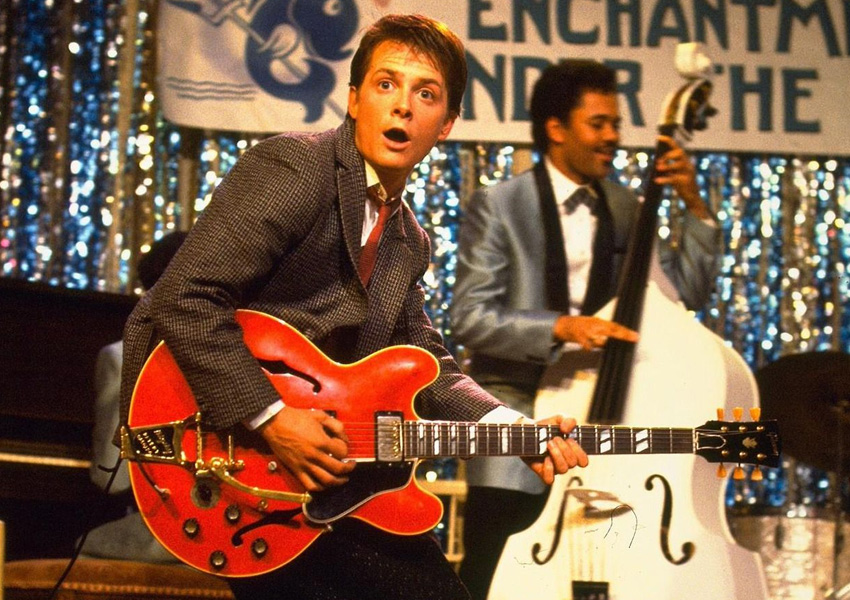
Likely the best-known and overall most-iconic movie on this list, 1985's Back to the Future has more than stood the test of time as a film. The music scenes have arguably inspired as many new players to pick up a guitar as any band or player did from that era. The guitar playing of Marty McFly, though pre-recorded and somewhat crudely mimed by star Michael J. Fox, continues to capture the hearts and imaginations of movie fans.
Let's check out the guitars that showed up throughout the film, one of which was again provided by Norman Harris of Norm's Rare Guitars.
Erlewine Chiquita Travel Guitar
The first guitar that shows up in BTTF is the Chiquita Travel Guitar built by legendary luthier Mark Erlewine and popularized by players such as Billy Gibbons and Stevie Ray Vaughan. A 27.5"-miniature, one-humbucker guitar at its heart, the Chiquita's small size is used for comedic effect in Back to the Future. Marty plugs the tiny Chiquita into what is perhaps the most comically oversized amp and speaker setup ever—built by the wiry mad scientist Doc Brown, of course—and proceeds to blow the speaker out and get himself tossed in the wall as a result of the sonic force.

Ibanez Roadstar II RS 430 MIJ
Marty McFly's main axe in the initial guitar scenes was coincidentally this author's favorite MIJ guitar of the 1980s—the Ibanez Roadstar II. Marty actually plays a black RS 430, which is a Roadstar II with a locking tremolo and SSS-pickup configuration. What makes this Fujigen-made guitar's appearance interesting and unexpected is that these guitars were not big sellers, to say the least, as we noted in our article on the history of '80s Ibanez.
What's worth noting even more is that, despite the film's massive success, it's not like its appearance in the movie did anything to boost the sales of the Roadstar II. The model in this incarnation was all but dropped less than two years after the film's release. To be fair, Marty did sound like the worst caricature of an EVH-obsessed '80s player when he played the guitar at the talent show auditions with his band the Pinheads. So that might have had something to do with it.
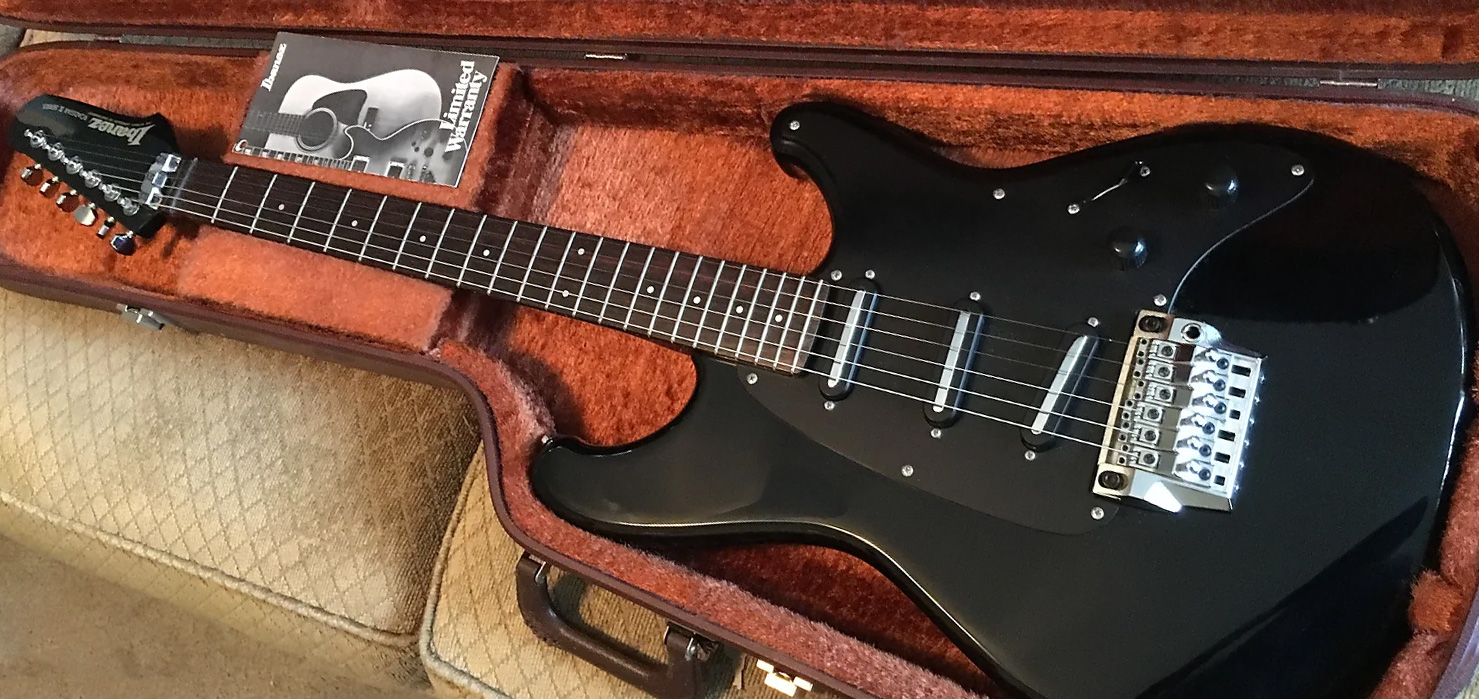
1959 Gibson ES-345 TDC
After traveling back in time to 1955, Marty finally gets the shot to play for his school. Granted, he's playing for his high school when his parents were still there, but he did it nonetheless. In what is arguably the most memorable movie scene of the entire 1980s, Marty McFly shreds through a blistering version of Chuck Berry's "Johnny B. Goode" before devolving back into Struggle Eddie (to coin a phrase) on a 1959 Gibson ES-345 TDC provided by Norman Harris.
According to Harris, the producers wanted a guitar that was "futuristic" for the time, so Harris initially suggested a Gibson ES-5 Switchmaster, which was period correct and fit the description. In true Hollywood fashion, the producers rented the guitar Norm suggested and didn't open the case for 11 weeks. When they finally did open the case and looked at the guitar, they didn't like it for the scene and returned it—instead requesting a red Gibson with a "whammy bar" in its place. Being a pioneer and proponent of films using period-correct instruments, Norm ultimately relented. He suggested the now iconic '59 ES-345 TDC as seen in the film.
Humorously, the producers ended up renting the guitar long enough that they could've purchased it outright for the money they spent. As Norm explains, money is often not an obstacle for major movie productions.
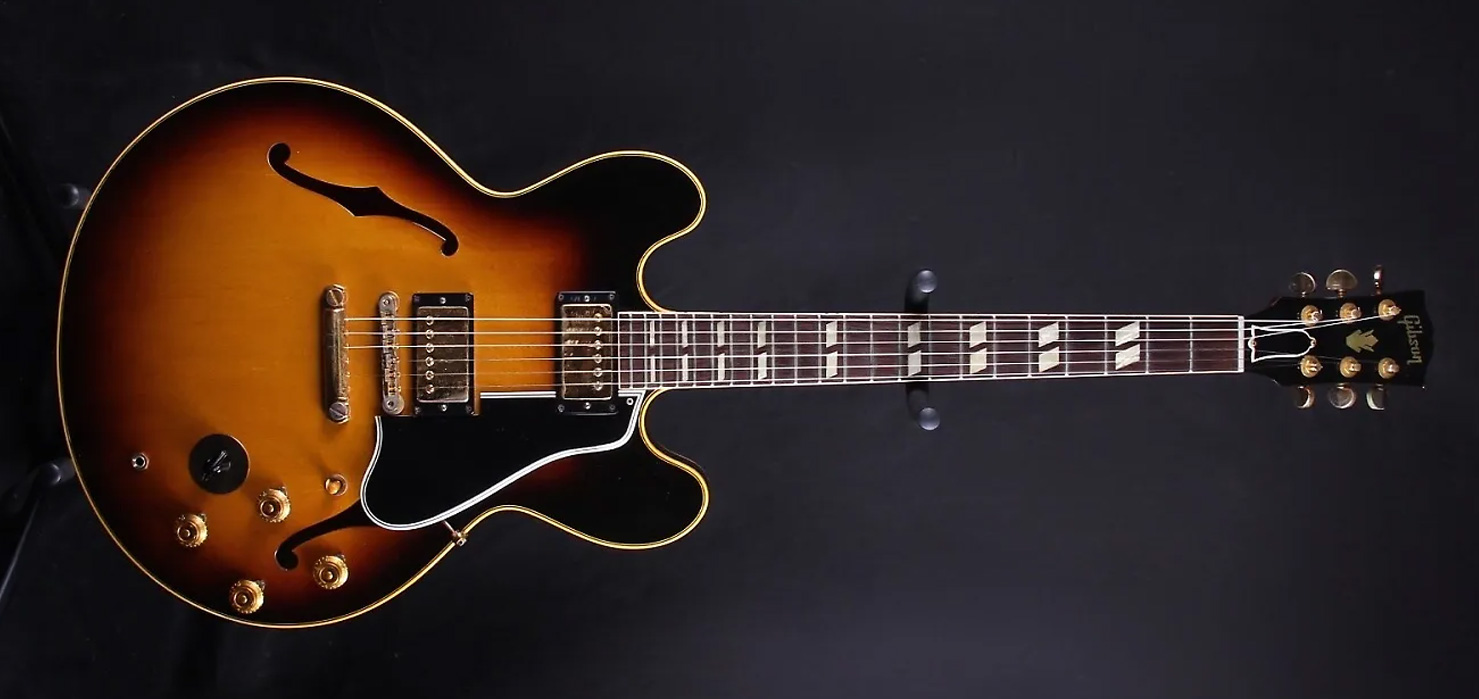
Next up on our list is not the undeniable cinematic masterpiece from 2002 starring Britney Spears but rather the 1986 Crossroads starring Ralph Macchio of Karate Kid.

It also featured noted thespian Steve Vai as the demonic guitarist-for-hire Jack Butler. A true B-movie about the blues (in the best way), Macchio spends most of the film being mentored by the famed Willie Brown, before taking on Vai's Jack Butler character in a head-cutting guitar battle over the ownership of Willie Brown's soul.
In all seriousness, this movie features the greatest cinematic guitar battle in history, with licks provided by Ry Cooder, Arlen Roth, and, obviously, Steve Vai. It is also the only movie in history where you can watch the literal Karate Kid get in a full-blown shred-off with Vai, so that alone at least is worth watching if you can't make it through the whole movie.
'68-'70 Fender Telecaster
Macchio's character ends up playing what is likely a late-'60s blonde Fender Telecaster, after Willie Brown bargains with a local shop-owner. Over the years on forums, there has been a bit of misinformation about whether or not this guitar was an actual Fender or if it was a relic'd Japanese Squier.
The truth is: There were multiple guitars used in Crossroads that were supposed to represent this same guitar. Each guitar served its own purpose (as far as the producers were concerned), with the Fender only being used for important shots and promotional photos. Hilariously enough, when the guitar first shows up on camera it is missing all of its strings.

'83-'84 Squier SQ Series or an '85 A-Series Squier Telecaster
While the vintage Fender Telecaster was the main guitar for Macchio's "Lightnin' Boy" character, in certain key scenes and close-ups—such as when he walks through the rain with his telecaster in nothing but a sack—they used the MIJ Squier stand-in. It is important to note that this wasn't your little brother's garbage Squier. Based on the alleged year of the guitar, 1983, it would have been an SQ-series Squier.
The Japanese SQ series of instruments was arguably the best Squier ever produced—some say even better than many of their USA Fender counterparts at the time, with the exception of the American Vintage Reissue series. Aside from it being an SQ-series Telecaster, it could as well have been an A-Series Squier Telecaster from around '85. The finish on these actually matches the vintage Fender used in Crossroads much more accurately and features most of the vintage-style appointments.

The only reason we actually know that a Squier was used at all on set, let alone an '83 Squier, is because Arlen Roth ended up listing it for sale on eBay in the mid-2000s, autographed by many of the cast and crew. Per his eBay description at the time:
Here's a real "Holy Grail" for collectors! This is one of the 2 Teles that were used in the legendary Guitar film, "CROSSROADS" by Ralph Macchio, and which was presented to me when I finished my work on the film. It was acquired by Columbia Pictures to help him learn with me ( I gave him 2 months of lessons before we started rolling in Mississippi!) and then was used during the film for closeups...
'80s Jackson San Dimas - Sparkle Red
Like Macchio's telecaster, over the years there has been some disagreement as to what Vai's main guitar in this movie actually was. The headstock decal was taped over in the movie, so it's pretty hard to tell exactly the brand of the guitar. Fans of the movie and of Vai have wondered for years—is it a Charvel or a Jackson?
To settle the debate once-and-for-all, it is actually a Jackson. How do we know this? Well, the guitar is currently on display at the Hard Rock Cafe in Biloxi, Mississippi, and through some guitar forum sleuthing, we were able to find pictures of the display. Lo and behold, on the pointy headstock is a giant Jackson logo in all of its '80s glory. To that end, Jackson actually did a limited-run reissue of the guitar a number of years back.
A lot of the confusion around the movie's Jackson actually comes from another Super Strat that makes a brief appearance in the guitar battle scene. Serving as a prop backup guitar for Vai's Butler character, this guitar was actually a Charvel. It's own interesting backstory is that it may have belonged to Eric Johnson. After the film, there's evidence that Vai may have gotten it re-necked by Grover Jackson. From that point on, this same guitar would have had a larger, endorsement-sized Charvel decal and rosewood fretboard.
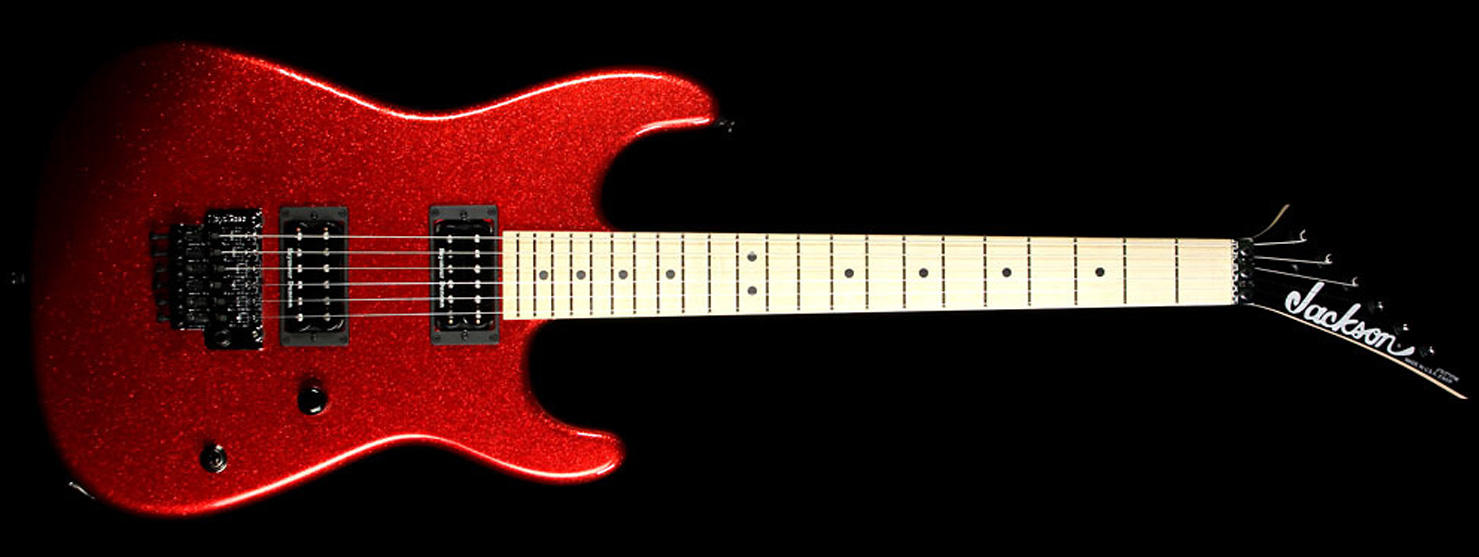
Purple Rain, as many of you already know, tells the story of a Minneapolis-based musician known as The Kid, played by Prince himself.
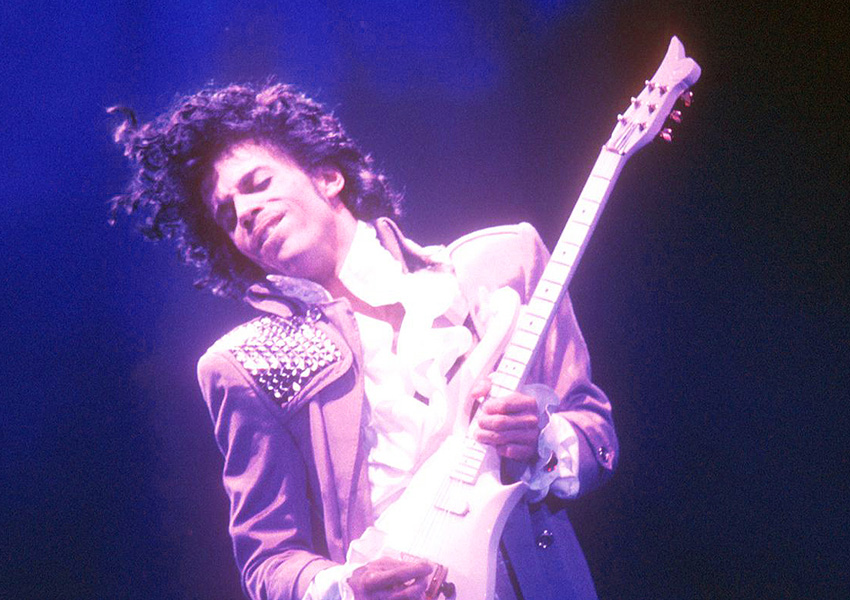
In the movie, The Kid plays local clubs with his band The Revolution. As you can tell, Prince was really stretching out as an actor…
Along the way, The Kid has to conquer his musical rival while navigating the trials and tribulations of true love and facing the demons that haunt him. This might not need to be said, but Purple Rain is the most Prince thing he probably ever conceived. That extends to the guitars that made their debut in this film.
Hohner Mad Cat Tele
When people think of early Prince guitars, most will fondly remember Prince playing a Telecaster. The actual guitar in question was essentially a lawsuit-era Tele clone. Specifically, it was a '70s Hohner Mad Cat, which Prince allegedly acquired in the late '70s in part because the distinctive tortoise pickguard matched well with his leopard strap. From there, Prince started using it as a main guitar both live and in recording around 1983, even keeping the pickups stock for many of the years to come. Prince would end up buying a number of Mad Cat Teles, and even had a number of elaborate copies made over the years.
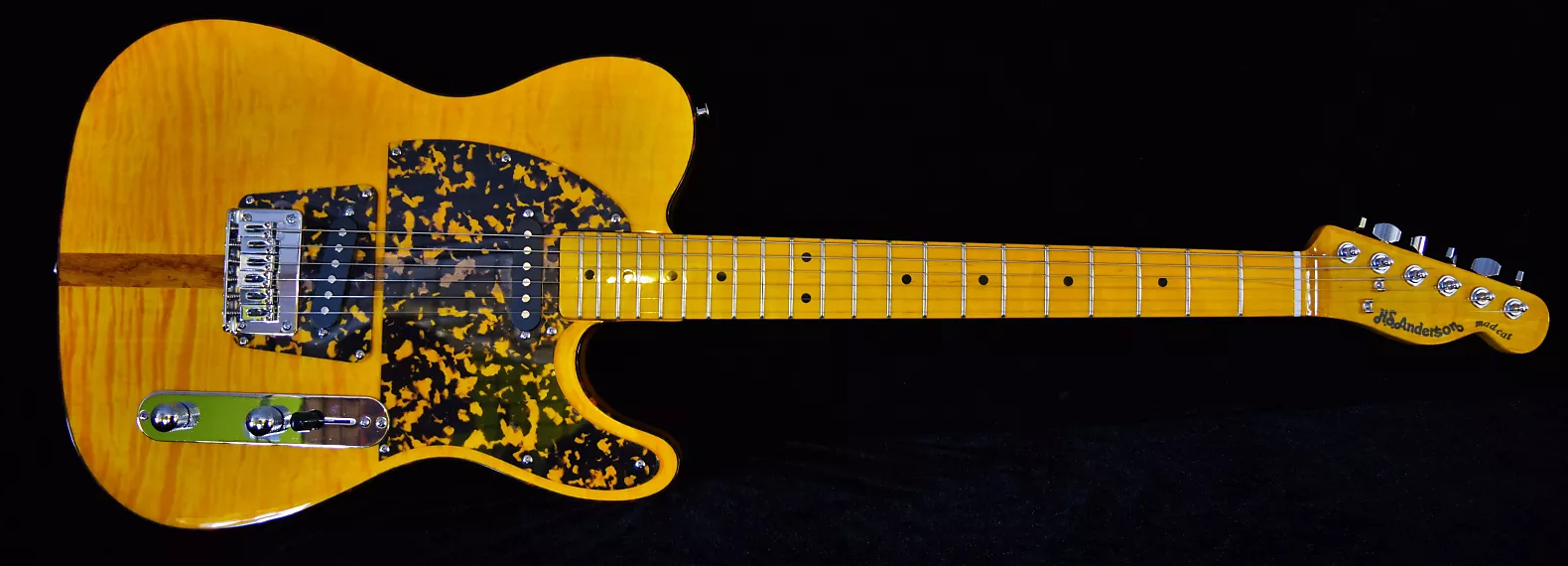
Cloud Guitar
The Cloud Guitar, arguably Prince's most signature guitar, made its first main appearance in Purple Rain, after it is gifted to The Kid by his fictional girlfriend. Given that these guitars cost thousands of dollars to commission, you have to stretch your imagination a bit to believe that scene, but Purple Rain is clearly not a movie devoid of absurdities.
Prince originally had the idea for the Cloud Guitar after falling in love years before with an unusually shaped instrument owned by bassist André Cymone. After 1999 became a smash hit in 1983, Prince got in contact with Minneapolis-based luthier and repairman Dave Rusan to make the out-of-this-world guitar a reality.
While Rusan, by his own admission, had never built a neck-through guitar like this before or made anything with this much hand-carving, Prince absolutely loved the guitar. He actually enjoyed it so much that he would commission three more from Dave by '85 and dozens upon dozens of more takes on the guitar from various luthiers throughout the '90s and 2000s.

1984 Purple Rickenbacker 330
Another absolutely killer guitar that makes an appearance in Purple Rain is the purple Rickenbacker 330 played by Wendy Melvoin, The Revolution's other guitarist. It is an absolutely gorgeous instrument and will make you love Prince's shade of purple as a guitar finish.
What made Wendy's 330 unique besides the finish is the fact that she modified it quite a bit. She sealed up the f-holes to reduce feedback and stop the movement of air within the body, and swapped in G&L pickups in place of the stock pickups. Now I know that some diehard Rickenbacker fans are cringing at this, but you shouldn't be—the mods clearly made for a great sound. Unfortunately, these specific guitars are currently MIA, as they were stolen from Wendy sometime in the early 1990s.
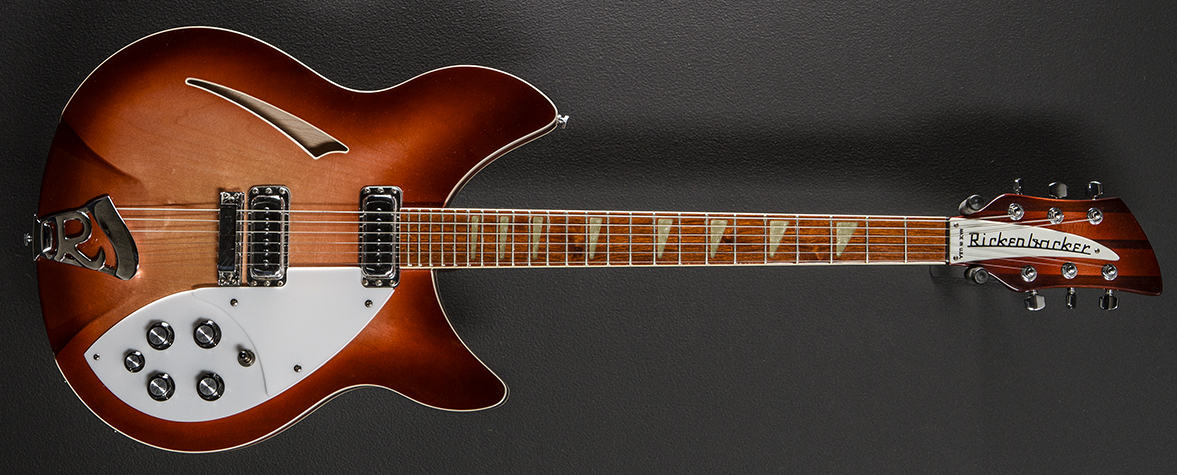
To end with a quick and sudden tragedy, we look to the Martin destroyed in The Hateful Eight. As many of you may remember from our initial coverage of the guitar massacre and Martin's response, Kurt Russell smashed a historic 145-year-old Martin loaned to the film by the Martin Guitar Museum. The irreplaceable museum piece was supposed to be swapped for a prop guitar before shooting the destruction scene, but apparently no one told Russell.
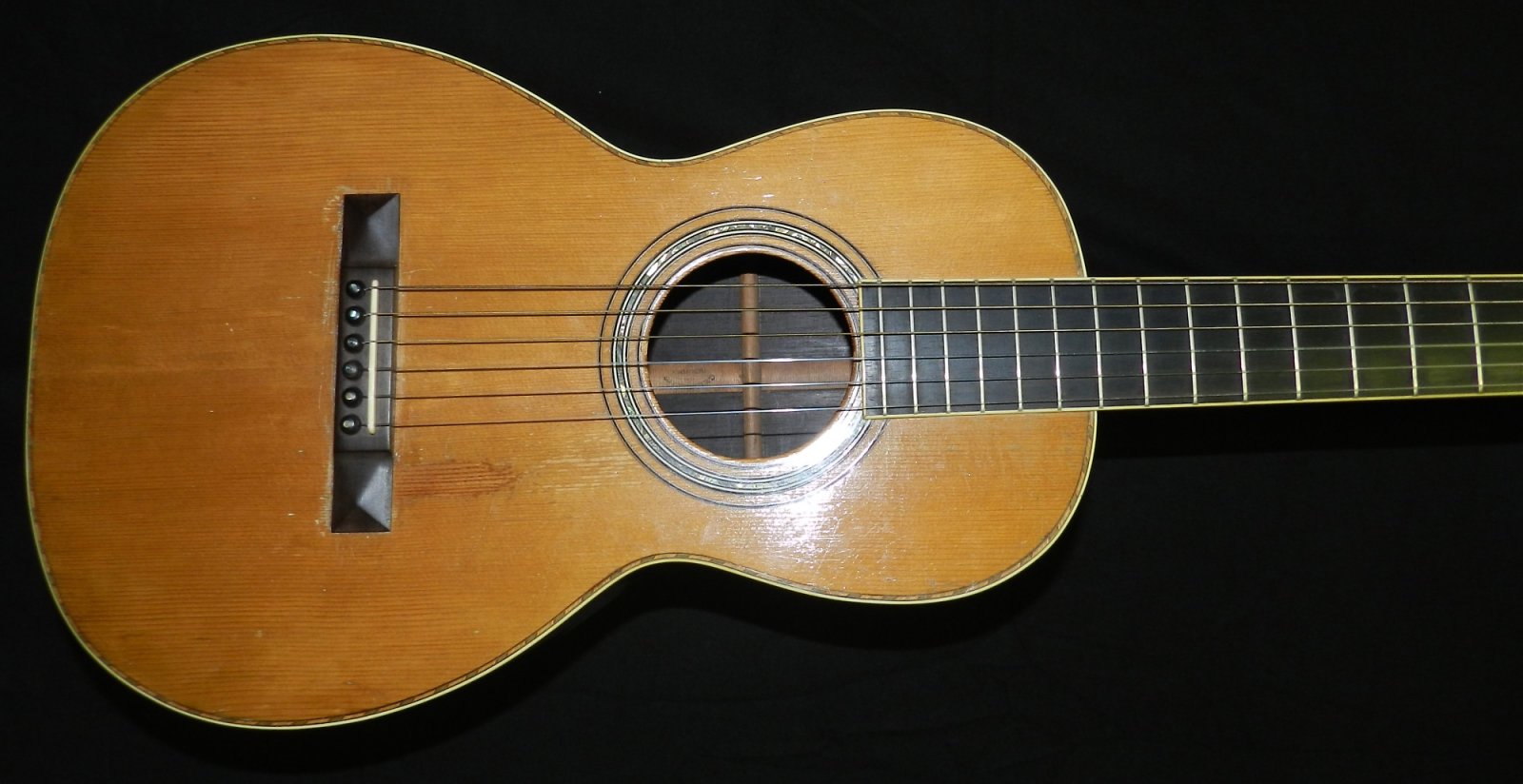
About the Author: Casey Hopkins is a Brooklyn-based writer and songwriter/guitarist for The Advertisers. Aside from writing for Reverb and pursuing music, Casey is a recovering guitar salesman, assembler, and history major. Follow @CaseyHopkinsGuitar on Instagram to keep up with him.
